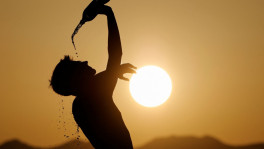A closer look at how people catch Covid-19
Getting the Covid-19 virus occurs in three steps: coughing, talking and breathing creates virus-carrying droplets of various sizes; enough virus has to make itself over to or build up around our organs over time to trigger an infection; and finally the virus has to make its way into the respiratory tract and use the ACE-2 receptors there to enter cells and replicate.

How does one catch the coronavirus? A simple enough question but one that has not been answered conclusively, or with a lot of clarity, so far.
Does it only spread when an infected person coughs or sneezes, or does it also spread if you speak to the infected person in close proximity?
Do asymptomatic patients spread the virus or only pre-symptomatic patients?
What are the actual chances of picking up the virus from contaminated objects and surfaces?
In a recently published article in The Wall Street Journal, the authors - the daily's Digital Science Editor Daniela Hernandez, reporters Sarah Toy and Betsy McKay, tried to delineate the answers to the question. The article looks at a myriad of ongoing researches to get closer to a more conclusive answer.
Health agencies have so far identified respiratory-droplet contact as the major mode of Covid-19 transmission. These large fluid droplets can transfer virus from one person to another if they land on the eyes, nose or mouth. But they tend to fall to the ground or on other surfaces pretty quickly.
However, scientists say that it is not common to contract Covid-19 from a contaminated surface; and fleeting encounters with people outdoors are unlikely to spread the coronavirus.
According to the authors of the article, the major culprit is close-up, person-to-person interactions for extended periods: crowded events, poorly ventilated areas and places where people are talking loudly – or singing.
Getting the Covid-19 virus occurs in three steps: coughing, talking and breathing creates virus-carrying droplets of various sizes; enough virus has to make itself over to or build up around our organs over time to trigger an infection; and finally the virus has to make its way into the respiratory tract and use the ACE-2 receptors there to enter cells and replicate.
One important factor in transmission is that seemingly benign activities like speaking and breathing produce respiratory bits of varying sizes that can disperse along air currents and potentially infect people nearby.
Aerosolized virus
Some researchers say the new coronavirus can also be transmitted through aerosols, or minuscule droplets that float in the air longer than large droplets. These aerosols can be directly inhaled.
Scientists have said that aerosolized virus from the patient's breathing or speaking can build up in the air over time and strong airflow from an air-conditioning unit on the wall may help recirculate the particles in the air. Some scientists say while aerosol transmission does occur, it does not explain most infections. In addition, the virus does not appear to spread widely through the air.
Sufficient ventilation in the places people visit and work is very important. Proper ventilation – such as forcing air towards the ceiling and pumping it outside, or bringing fresh air into a room – dilutes the amount of virus in a space, lowering the risk of infection.
Prolonged exposure to the virus
"Prolonged exposure is generally defined as 15 minutes or more of unprotected contact with someone less than six feet away," said John Brooks, the US Centers for Disease Control and Prevention's (CDC) chief medical officer for the Covid-19 response.
"But that is only a rule of thumb, he cautioned. It could take much less time with a sneeze in the face or other intimate contact where a lot of respiratory droplets are emitted," he said.
Superspreaders
"Superspreader" events are those in which one or a small number of people infect many others. When singing, people can emit many large and small respiratory particles. Singers also breathe deeply, increasing the chance they will inhale infectious particles.
Similar transmission dynamics could be at play in other settings where heavy breathing and loud talking are common over extended periods, like gyms, musical or theater performances, conferences, weddings and birthday parties.
An estimated 10 percent of people with Covid-19 are responsible for about 80 percent of transmissions, according to a study published recently in Welcome Open Research.
"The risk of a given infected person transmitting to people is pretty low," said Scott Dowell, a deputy director overseeing the Bill & Melinda Gates Foundation's Covid-19 response.
"For every superspreading event you have a lot of times when nobody gets infected."
Amount of viral RNA in the body
Scientist are unsure about how much virus it takes for someone to become infected, but recent studies offer some clues. In a study published recently in the journal Nature, researchers were unable to culture live coronavirus if a patient's throat swab or milliliter of sputum contained less than one million copies of viral RNA.
"Based on our experiment, I would assume that something above that number would be required for infectivity," said Clemens Wendtner, one of the study's lead authors and head of the department of infectious diseases and tropical medicine at München Klinik Schwabing.
He and his colleagues found samples from contagious patients with virus levels up to 1,000 times, which could help explain why the virus is so infectious in the right conditions: it may take much lower levels of virus than what's found in a sick patient to infect someone else.
The bigger risks are close-range face-to-face interactions, and having lots of people in an enclosed space for long periods. High-touch surfaces like doorknobs are a risk, but the virus degrades quickly so other surfaces like cardboard boxes are less worrisome, according to Erin Bromage, a University of Massachusetts Dartmouth associate professor of biology.
Worrying places are the break rooms, locker rooms and security checkpoints, where people interact. The so-called attack rate – the percentage of people who were infected in a specific place or time – can be very high in crowded events, homes and other spaces where lots of people are in close, prolonged contact.
Being outside is generally safer, experts say, because viral particles dilute more quickly. But small and large droplets pose a risk even outdoors, when people are in close, prolonged contact, the article stated quoting Linsey Marr, a Virginia Tech environmental engineering professor who studies airborne transmission of viruses.
Emerging findings are helping businesses and governments devise reopening strategies to protect public health while getting economies going again. It includes tactics like installing plexiglass barriers, requiring people to wear masks in stores and other venues, using good ventilation systems and keeping windows open when possible.
Studies showed that wide-scale lockdowns, stay-at-home orders, bans on large gatherings and business closures have prevented millions of infections and deaths around the world.
"We should not be thinking of a lockdown, but of ways to increase physical distance," said Tom Frieden, chief executive of Resolve to Save Lives, a nonprofit public-health initiative.
Innovative methods that can facilitate resumption of economic activity without a rekindling of the outbreak are our best chance of not catching the Covid-19.


 Keep updated, follow The Business Standard's Google news channel
Keep updated, follow The Business Standard's Google news channel















